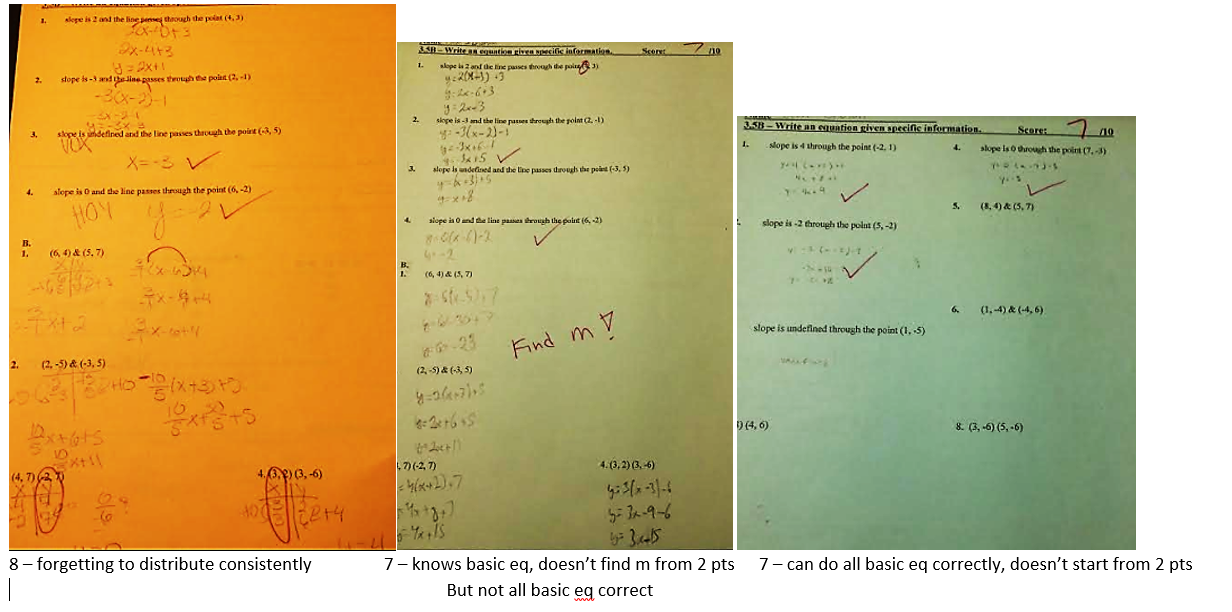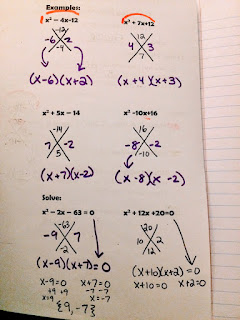(And I pretty much should have written this after copresenting a session on SBG at #TMC15...sorry guys #betterlatethannever)
Some background real quick: I don't teach in a school/district that is full-blown SBG so I use what I call "SBG lite" that lets me operate in the traditional system but hold many of the ideals of SBG.
I teach high school, 90 minute block classes. Math 1 I see every day, others I see every other (A/B day), but have taught those on straight block as well. I usually test every 5 periods (when they see me on a Friday basically). Tests don't usually take all or even half of a period.
I will follow up once these stupid pictures load with another post including pictures of how I scored certain sections of some math 1 standards so you can get an idea of how the 5-10 works in practice with examples.
Here it goes...
I score on a 5-10 for ease of translating to a “traditional”
grade (easier to communicate than the traditional 1-4 rubric for students,
parents, and admin)
I like this ninja poster (just search ninja SBG to see lots of versions online) to roughly explain how I
think (blue) when looking at the work and how a student feels (black text) when
doing the work at each level.
In general here is I define the levels:
10 – perfect, no errors including notation if applicable
9. 5 – Very minor arithmetic mistake
9 – Arithmetic mistakes or mistake that doesn’t generally show a
*conceptual* misunderstanding
8 – conceptual misunderstanding (has gist of it but is still
missing a puzzle piece)
Easier to come from the bottom now:
5 – nothing or just…wrong. If everything is blank (or not a
real effort) I will give a 0.
6 – Can get started or understands one piece of the problem
but gets very stuck
7 – A step above 6. Usually a combo of conceptual misunderstandings
and arithmetic mistakes
FAQs:
How do you do retesting?
- For Math 1 – 3, I embed retesting in the next
assessment and it is mandatory for all students. I do this for many reasons,
not the least of which is I want all students (even those with an initial 10)
to show they’ve retained the material. Search for research on “retrieval
practice” and the “testing effect” to see why this is crucial for transfer to
long-term memory for all students.
- Doesn’t this make the test long? No, it is similar
in length to when I did a traditional test (about 1 page front and back,
sometimes longer). But I’m much better about writing questions now. Don’t ask 3
of the same question if one will suffice. It’s not about *points* (ie more
questions = less points per question) but about the type of mistakes.
- Example of setup. Say it’s our second test. The
first part will be retesting on the first test (A) (similar questions) plus the
new material (B). The next week B will be the review material and whatever was
taught the next week (C) will be new material. If there are certain standards
they are still struggling with, those individual topics might get looped to another week after the initial retest.
- Students see topics again in a quarter test that
is cumulative. For YL courses the next quarters will have sections for review
on prior units. For instance, my 8 standards for unit 1 (Math 2) might collapse
down to 1A Operations on Polynomials and 1B Factoring. By end of the year it
will just be unit 1 and will be the most challenging questions only.
- Jury is still out on exactly how I will implement retesting in Precalc this year as the material is just so much longer. I'm thinking retesting IS on them to request out of class and will require HW to be complete and a remedial practice set on the standard in DeltaMath to be completed. They will still have the cumulative aspect of the units carrying through the course to hold them accountable in the future.
How many standards do you have?
- I have between 5-8 standards per unit depending
on the length of the unit
- If you feel like something is a “power standard”
then you can adjust the weight in your gradebook (like in my honors Math 2 I make
trig word problems weighted 2 times because I feel that application is crucial)
How many questions per standard?
- It depends on how long the problems take, I'd say the median is probably 4-5. Just enough to test the different levels of a topic. For instance with difference of squares I'm going to have 4: one normal, one that is "backwards" (constant first), one with two variables, and one with both terms being something besides one (like 9x^-25). In math 2 one of those will also have fractions. It can be as low as 2 or 3 (normal for quadratic formula for me) or higher if we are IDing transformations
- Choose the lowest possible number of questions you need to accurately see their level of understanding. This has made me think more critically about the questions I ask. No reason to ask something of the same level 3 times if 1 will suffice. Make sure there is a more "basic" question to see if they have some grasp of the concept.
What is response from stakeholders?
- After one explanation of my grading to a parent,
I have not had a *single* issue about my grading in the 4 years I have used it.
In fact, I get consistent feedback from students, parents, and guidance
counselors that they appreciate this method because:
o
It lowers test anxiety and helps students see a
test as just a data point about where they are in the journey of their learning
(not the end)
o
Students retain information better because of
being held accountable for it over time
o
Everyone is on the same page instead of not
knowing what a 73 on a test means. Now everyone knows the student needs to work
on 2.3, 2.5, and 3.1
If you are only entering grades for tests, how do you get
students to do anything?
- Grading is not the only way to hold students
accountable. You can still be recording classwork/homework in some way to have
discussions with students, parents, and guidance and even put this in
your gradebook without that having to calculate in the actual grade.
- Consider: are you grading compliance or content?
I’d argue I want my grade to accurately represent what they know about the
course. That doesn’t mean there isn’t communication etc about work ethic and
such things or consequences for not doing certain things, but those are taken
out of the grading equation.
- Once you take out any grading of formatives, the
nature of your class will switch because students don’t ask “will this be
graded?” because they know it won’t and instead will do the work you are asking
them to do because it is how they are going to learn it to do well on what is
graded (assessments).
- Incorporate activities and structures in your
class that make not participating a kind of non-option (speed dating, #vnps (whiteboards), other games where everyone has to do work)
Aren’t we not preparing students for the real world?
- First, I’d argue that a lot of things in the real
world require constant revision in the search for doing things better (think
about teaching!).
- Second, my main goal is to have students learn
as much of my content as possible. What will prepare them for the future in
math class isn’t some arbitrary responsibility taught through 0s (how many
students have changed habits from receiving a 0 from you?) but instead knowing
the foundational math concepts in my class.
- If (for instance) these gaps of understanding in
my Math 1 class aren’t filled, they aren’t going to be closed in Math 2 and
these students will fall farther behind. It is my goal to have students learn
and master as much of my material as possible so that they can be successful
later in their math career. Close the knowledge gaps now.
What do you do with the different scores on a standard?
- Over the past 8 semesters of doing this, I’ve
done pretty much everything. Average, average two most recent, just most
recent. I’ve been doing most recent since what I care about is where we are
ending up. In the RARE case they go down on a quarter test significantly, I
look at what their consistent score.
- I did like one semester where they got a 9.5 the
first time it was perfect, and the next time it was perfect it changed to a 10.
But at the end of quarter this took SO long to deal with after the quarter test
it wasn’t worth it, in my opinion.
Random Advice:
- Embed reteaching on these standards in class
and/or homework (cue Math Maintenance!!!) so that students have an opportunity to receive corrective
feedback and improve through practice before the next test.
- Have
a way for students to record their progress so they can see it is working!
Whew! That was long. This is what works for me and one of the keys, as in anything with teaching, is finding the right combination for you. I've found this method keeps everyone on the same page and is pretty easy for students and parents to quickly grasp.



























